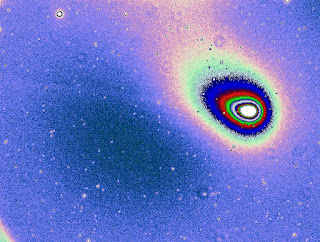Extra Physics Photo
Comet ZTF update #3 - False colors for increased contrast
February 16, 2023 - photograph by Donald Collins on Feb. 13, 2023
On Monday, Feb. 13, 2023, the comet did not show all these weird colors. After all, the CCD camera used on the 14 inch telescope is a monochrome camera. False colors were used in the processing software were used to illustrate some of the structure in the monochrome image. The colors are chosen to indicate the brightness of the pixels involved.
The previous posts of this comet that were made with the CCD camera on the 14 inch telescope showed no structure in the head of the comet because all the pixels were displayed as white in order to show any of the tail. The head of the comet is actually brighter in the middle than it is on the sides. The false colors, especially if the colors are chosen appropriately, show the brightness level contours - each distinct color is a contour of constant brightness - with the brightest part of the head centered over the comet's nucleus. The picture at right is a typical monochrome image showing a featureless head, but we can still see the dust tail streaming off towards the upper left.
The false color image shows the head (top picture) to be "egg-shaped" with the head contours tailing slightly upwards toward the left. The contours show the direction of the tail much better than the monochrome image, especially within the bright comet's head. The false color clearly shows the fainter outer tail to be more deflected towards the image right as it becomes further away from the comet. Comet tails are typically curved when viewed from Earth. The curvature primarily arises because the dust particles of the tail move further away from the Sun due to the "pressure" of the solar radiation. Yes, light exerts a pressure on dust particles. Photons - the quanta of light - behave like particles and actually carry momentum and can impart their momenta onto small particles! As the dust particles move further away from the Sun, they are still in an orbit around the Sun, but spiral outward in the Solar System, they travel more slowly around the Sun because the Sun's gravitational force diminishes. The diminished gravity as well as inertial "forces" cause the curvature in a comet's tail. The comet's tail thus resembles the common punctuation mark of the similar name: ",".
One more feature brought to light by the false color technique is that the comet has a second, straight tail, much fainter than the bright dust tail. The picture at left is a 2-image "blink". The 2-images of the "blink" were taken 16 minutes apart. Notice that the slightly-slanted straight tail remains "attached" to the comet as the comet moves through the stars between the two images. It is not an artifact. False coloring of monochrome images provides a good method to enhance the contrast of images to show small faint details in the structure.
The straight ion tail consists of charged atoms called ions. The atoms of the comet's volatiles have had their electrons stripped away by the intense ultraviolet (UV) radiation from the Sun. Charged particles in a trajectory in space follow the interplanetary magnetic field lines of the Sun. The magnetic forces on moving ions are much stronger than the gravitational and inertial forces that the dust particles of the curved dust tail exhibit. These images also demonstrate that the density of ions in the ion tail is much less than the number density of the dust particles in the comet's main tail because this ion tail is much fainter than the dust tail.






Comments
Post a Comment